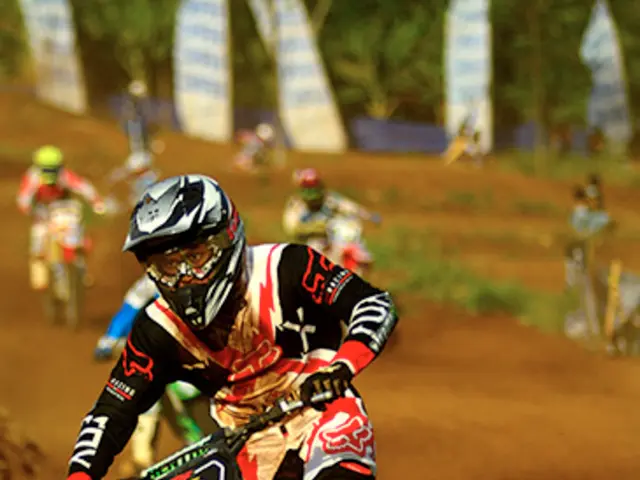Modifying Your Visual Focus and Head Angle to Boost Exercise Performance
In the realm of fitness and athletic performance, maintaining a conscious control over head and gaze position during exercise has emerged as a crucial factor in enhancing overall performance, muscle activation, injury prevention, and balance.
Research indicates that a stable head position and controlled gaze can significantly improve the accuracy and velocity of eye movements, known as saccades, which are essential for visual tracking and coordination during various athletic tasks. For instance, targeted eye movement training that requires a steady head position can enhance saccadic amplitude and peak velocity, potentially improving visual-motor integration vital for sports performance [1]. Similarly, focusing the gaze directly ahead during activities like cycling can boost efficiency and output, particularly in lower-level athletes [3].
The link between head and gaze positions and balance is also evident. Head and gaze positions are closely tied to vestibular and proprioceptive inputs that govern balance. Disruptions or specific manipulations can affect postural control. For example, visual-vestibular conflicts induced by optokinetic stimulation can influence postural stability, and immersive VR-based stimulation can modulate head and trunk control [5]. Aerobic-strength exercises that engage sensory-motor systems also improve postural stability and dual-task gait performance, suggesting that head/gaze coordination with body movement plays a role in stability [4].
Moreover, proper head and gaze positioning can enhance neuromuscular control by optimizing proprioceptive feedback and muscle activation patterns. Manual therapies and mobilizations aimed at improving joint alignment and movement mechanics—often in conjunction with controlled head and gaze posture—reduce time to stabilization after dynamic tasks, implying improved joint stability and potentially lowering injury risk [2].
In practical terms, during exercises like deadlifts, Warrior poses, squats, and lifting exercises, maintaining proper head and gaze position is paramount to maintaining proper form and maximizing the effectiveness of each rep. For instance, in Warrior poses, where the body is twisted, the gaze should follow the front hand or extend over the front arm to engage the core and enhance balance. In squats, the head should be in a neutral position, looking forward. During lifting exercises, proper head and gaze positioning can help prevent neck strain, especially during exercises that require lifting heavy weights or performing dynamic movements.
In dynamic exercises like running, cycling, or high-intensity interval training (HIIT), maintaining an upright, neutral head position helps optimize lung capacity and stamina. In balancing exercises like single-leg stands, lunges, and balance board exercises, focusing the eyes on a fixed point in front of you or a spot on the floor helps enhance the sense of equilibrium.
In conclusion, controlling head and gaze position during exercise enhances neuromuscular coordination, optimizes muscle activation patterns, improves balance and postural stability, and contributes to injury prevention by ensuring accurate sensory input and more efficient motor responses [1][2][3][4][5]. These factors underscore the importance of integrated visual and vestibular strategies in athletic training and rehabilitation contexts.
- Maintaining a stable head position during exercise is crucial in enhancing the accuracy and velocity of eye movements, a key factor for visual tracking and coordination.
- Eye movement training that requires a steady head position can improve saccadic amplitude and peak velocity, potentially boosting visual-motor integration vital for sports performance.
- Focusing the gaze directly ahead during activities like cycling can boost efficiency and output, particularly in lower-level athletes.
- Proper head and gaze positioning can enhance neuromuscular control by optimizing proprioceptive feedback and muscle activation patterns.
- Manual therapies and mobilizations that improve joint alignment and movement mechanics through controlled head and gaze posture can improve joint stability and potentially lower injury risk.
- During exercises like deadlifts, Warrior poses, squats, and lifting exercises, maintaining proper head and gaze position is essential to maximize the effectiveness of each rep and maintain proper form.
- In dynamic exercises like running, cycling, or HIIT, maintaining an upright, neutral head position helps optimize lung capacity and stamina.
- In balancing exercises like single-leg stands, lunges, and balance board exercises, focusing the eyes on a fixed point in front helps enhance the sense of equilibrium.
- Integrated visual and vestibular strategies are essential in athletic training and rehabilitation contexts to enhance neuromuscular coordination, optimize muscle activation patterns, and contribute to injury prevention.
- Incorporating exercises focused on head and gaze position control into health and wellness routines can optimize fitness-and-exercise regimens, considering the science behind these interactions.




